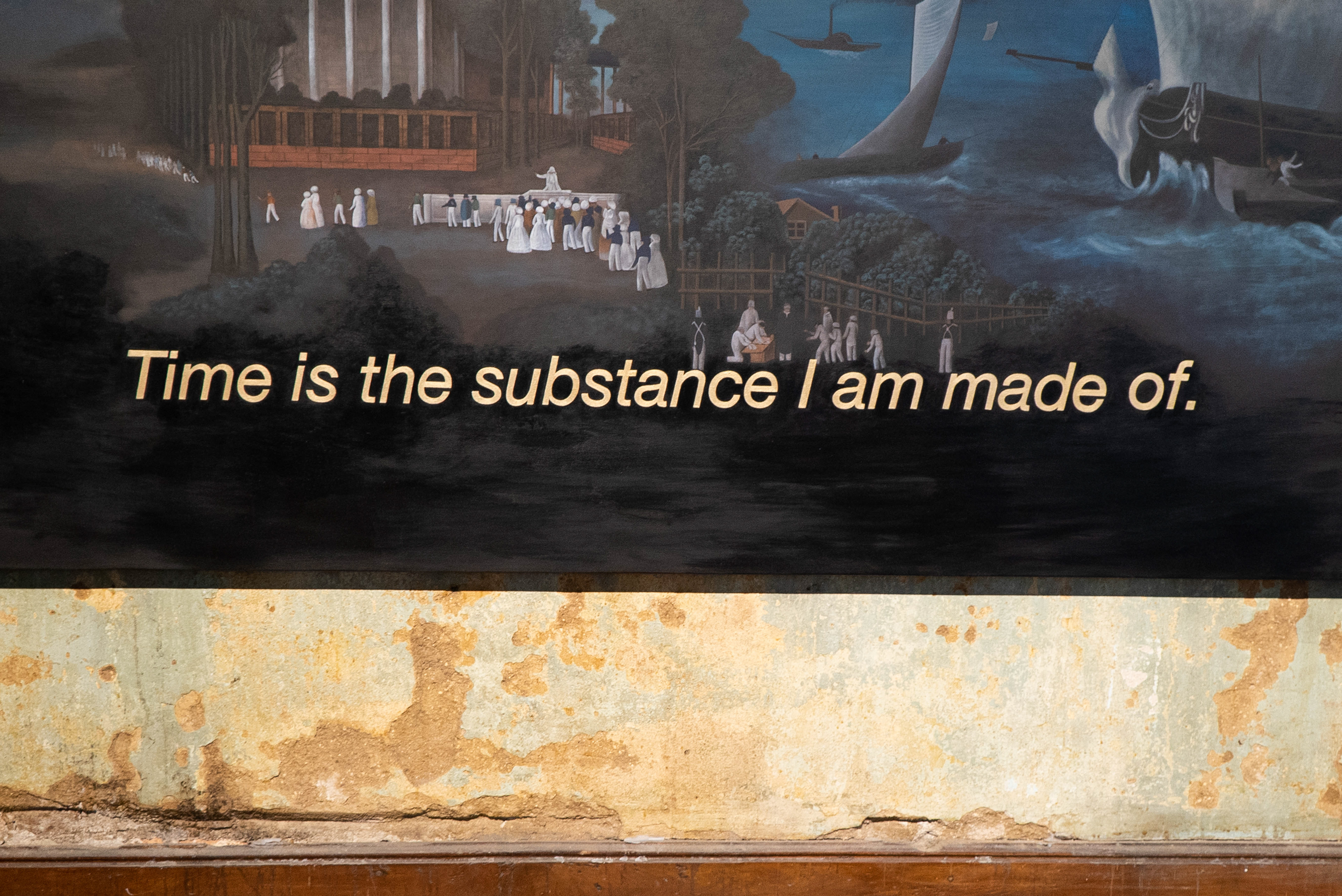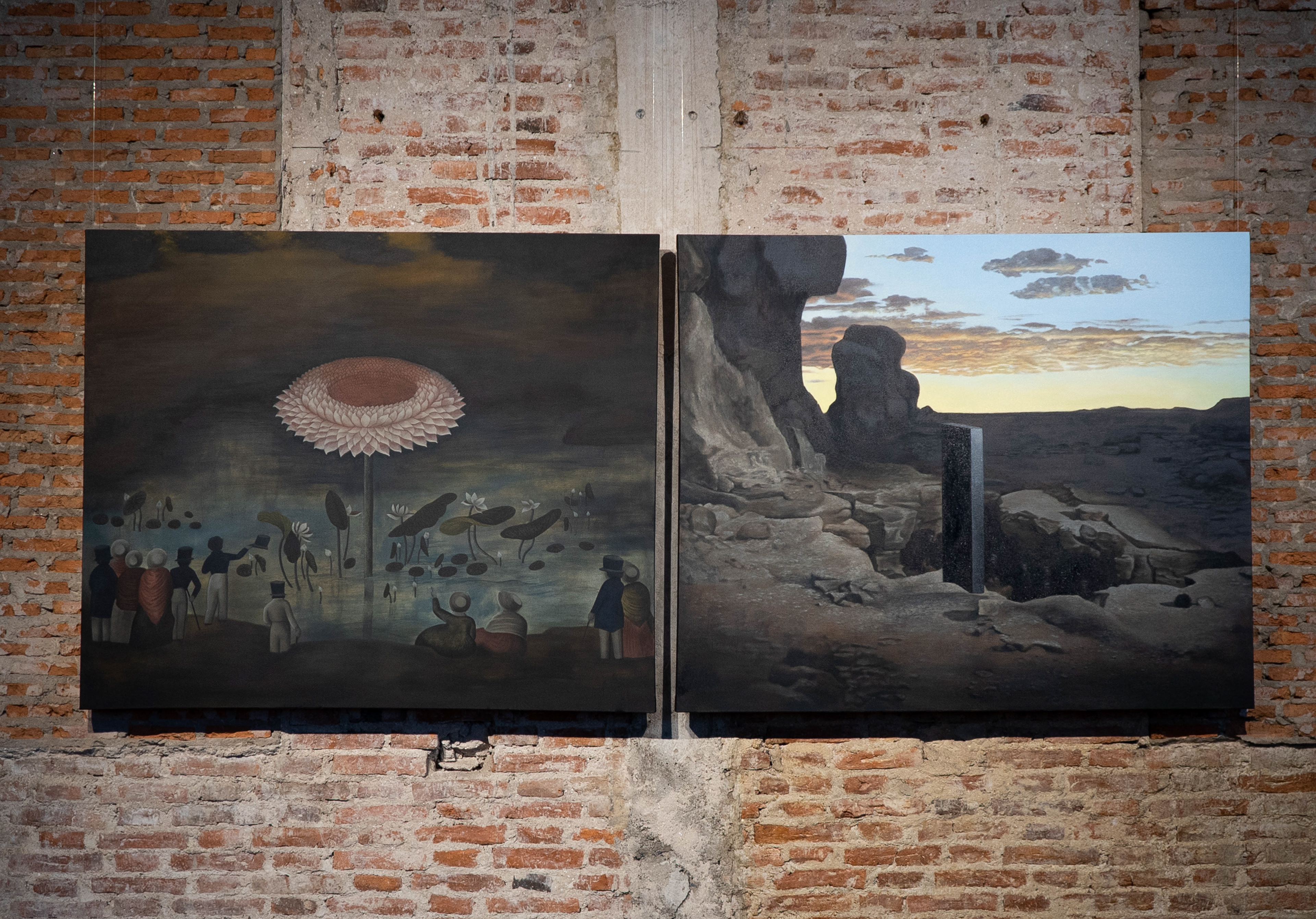

Time is the substance I am made of
2025
Acrylic and gold leaf on canvas
250 x 600 cm (Triptych)
Sirawit Chatu’s triptych, Time is the Substance I Am Made Of, is a profound continuation of the artist’s ongoing inquiry into time, identity, and the architecture of history. Drawing its title from a line in Jorge Luis Borges’ poetry, famously echoed in Jean-Luc Godard’s Alphaville, this work resonates with existential weight. It ventures into the turbulent confluence of historical memory and cultural fabrication, harnessing the imagery of the Chao Phraya River—a lifeline through Bangkok’s geography and history—and the reproduced murals of Krua In Khong (ขรัวอินโข่ง), a pivotal figure in 19th-century Thai art.
Created during a period marked by Western colonial incursions and the rapid modernization of Siam, Krua In Khong’s murals embody a hybrid cultural aesthetic. They are artifacts of a nation in flux, capturing the negotiation between tradition and modernity. By recontextualizing these historical works within his triptych, Chatu not only revives their visual splendor but reframes them as sites of interrogation—challenging how history, identity, and national narratives are constructed and preserved. The flow of the Chao Phraya River within the artwork serves as a metaphor for temporal fluidity, evoking the ceaseless merging of past and present, reality and mythology.
Created during a period marked by Western colonial incursions and the rapid modernization of Siam, Krua In Khong’s murals embody a hybrid cultural aesthetic. They are artifacts of a nation in flux, capturing the negotiation between tradition and modernity. By recontextualizing these historical works within his triptych, Chatu not only revives their visual splendor but reframes them as sites of interrogation—challenging how history, identity, and national narratives are constructed and preserved. The flow of the Chao Phraya River within the artwork serves as a metaphor for temporal fluidity, evoking the ceaseless merging of past and present, reality and mythology.

The Divided Self
2025
Acrylic on canvas
100 x 240 cm (Diptych)
SIRAWIT CHATU’s diptych, The Divided Self, emerges as an evocative dialogue between cultural memory and speculative futurism, juxtaposing the reproduced 19th-century Thai mural of Krua In Khong’s giant lotus with the iconic monolith scene from Stanley Kubrick’s 2001: A Space Odyssey. Both images, though distinct in origin, conjure surreal landscapes that resonate with the uncanny, capturing the sublime forces that shape human understanding across temporal and spatial dimensions.
The lotus, as rendered in Krua In Khong’s mural, holds deep symbolic significance in Thai culture. Its ethereal presence in the artwork, towering over groups of onlookers, evokes the Buddhist metaphors of enlightenment and transcendence. The mural’s historical context, rooted in a Siam grappling with modernization and colonial influence, positions the lotus as both a cultural anchor and a site of introspection. By reproducing this mural, Chatu reclaims its significance while inviting a reconsideration of its meaning in contemporary times. In stark contrast, Kubrick’s monolith, a symbol of alien intelligence and evolutionary leaps, is situated in a barren, otherworldly landscape. Its austere geometry and inscrutable purpose stand as a stark antithesis to the organic vitality of the lotus. Yet, both the lotus and the monolith are catalysts—objects that evoke awe, curiosity, and the sense of encountering something beyond human comprehension.
The lotus, as rendered in Krua In Khong’s mural, holds deep symbolic significance in Thai culture. Its ethereal presence in the artwork, towering over groups of onlookers, evokes the Buddhist metaphors of enlightenment and transcendence. The mural’s historical context, rooted in a Siam grappling with modernization and colonial influence, positions the lotus as both a cultural anchor and a site of introspection. By reproducing this mural, Chatu reclaims its significance while inviting a reconsideration of its meaning in contemporary times. In stark contrast, Kubrick’s monolith, a symbol of alien intelligence and evolutionary leaps, is situated in a barren, otherworldly landscape. Its austere geometry and inscrutable purpose stand as a stark antithesis to the organic vitality of the lotus. Yet, both the lotus and the monolith are catalysts—objects that evoke awe, curiosity, and the sense of encountering something beyond human comprehension.
No one has ever lived in the past. No one will ever live in the future.
2025
Acrylic and gold leaf on canvas
100 x 120 cm
Acrylic and gold leaf on canvas
100 x 120 cm
The artwork resonates deeply with Walter Benjamin’s reflections on history. In his Theses on the Philosophy of History, Benjamin contemplates Paul Klee’s Angelus Novus, describing an angel of history caught in the storm of progress—its wings outspread, its gaze fixed upon the wreckage of the past, yet helpless to intervene. This vision aligns with the Buddhist doctrine of impermanence, which reminds us that time is not a linear path but a continual unfolding of Jetztzeit, or “now-time.” Chatu’s work embodies this philosophical convergence, inviting viewers to abandon the illusion of chronological sequence and step into the immediacy of the present. This painting proposes an idea that the past is neither a place to return to nor a foundation upon which to stand. Instead, history is an ever-receding mirage, only made legible through the lens of the present moment. Chatu’s juxtaposition of text and image reminds us that history is not a relic, nor a prophecy—it is an echo that only becomes audible in the now.